Resilient agriculture: Several agreements concluded
Several climate change agreements were signed in Benguérir, Morocco, promoting climate resilient agriculture. Read more here.
Several climate change agreements were signed in Benguérir, Morocco, promoting climate resilient agriculture. Read more here.
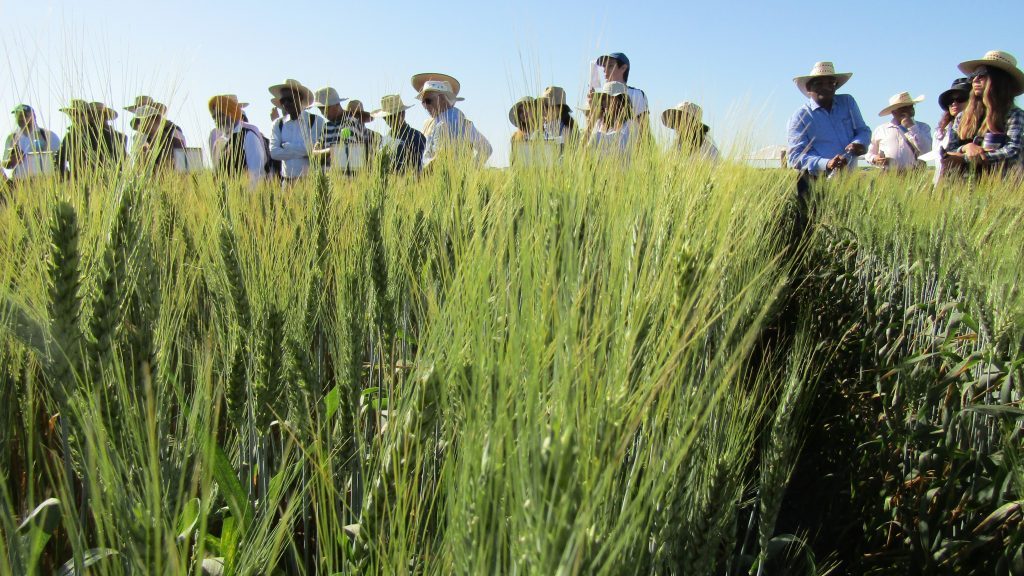
For a number of reasons, including limited interdisciplinary collaboration and a dearth of funding, revolutionary new plant research findings are not being used to improve crops.
“Translational research” — efforts to convert basic research knowledge about plants into practical applications in crop improvement — represents a necessary link between the world of fundamental discovery and farmers’ fields. This kind of research is often seen as more complicated and time consuming than basic research and less sexy than working at the “cutting edge” where research is typically divorced from agricultural realities in order to achieve faster and cleaner results; however, modern tools — such as genomics, marker-assisted breeding, high throughput phenotyping of crop traits using drones, and speed breeding techniques — are making it both faster and cost-effective.
In a new article in Crop Breeding, Genetics, and Genomics, wheat physiologist Matthew Reynolds of the International Maize and Wheat Improvement Center (CIMMYT) and co-authors make the case for increasing not only funding for translational research, but the underlying prerequisites: international and interdisciplinary collaboration towards focused objectives and a visionary approach by funding organizations.
“It’s ironic,” said Reynolds. “Many breeding programs have invested in the exact technologies — such as phenomics, genomics and informatics — that can be powerful tools for translational research to make real improvements in yield and adaptation to climate, disease and pest stresses. But funding to integrate these tools in front-line breeding is quite scarce, so they aren’t reaching their potential value for crop improvement.”
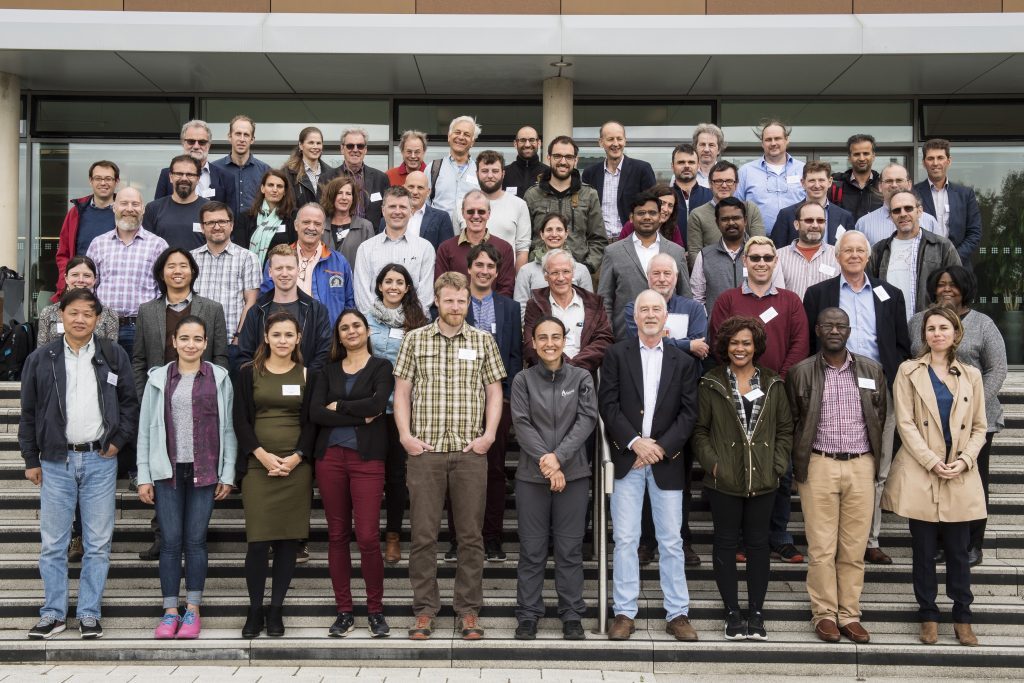
Many research findings are tested for their implications for wheat improvement by the International Wheat Yield Partnership (IWYP) at the IWYP Hub, a centralized technical platform for evaluating innovations and building them into elite wheat varieties, co-managed by CIMMYT at its experimental station in Obregon, Mexico.
IWYP has its roots with the CGIAR Research Program on Wheat (WHEAT), which in 2010 formalized the need to boost both wheat yield potential as well as its adaptation to heat and drought stress. The network specializes in translational research, harnessing scientific findings from around the world to boost genetic gains in wheat, and capitalizing on the research and pre-breeding outputs of WHEAT and the testing networks of the International Wheat Improvement Network (IWIN). These efforts also led to the establishment of the Heat and Drought Wheat Improvement Consortium (HeDWIC).
“We’ve made extraordinary advances in understanding the genetic basis of important traits,“ said IWYP’s Richard Flavell, a co-author of the article. “But if they aren’t translated into crop production, their societal value is lost.”
The authors, all of whom have proven track records in both science and practical crop improvement, offer examples where exactly this combination of factors led to the impactful application of innovative research findings.
Other successes include new approaches for improving the yield potential of spring wheat and the discovery of traits that increase the climate resilience of maize and sorghum.
One way researchers apply academic research to field impact is through phenotyping. Involving the use of cutting edge technologies and tools to measure detailed and hard to recognize plant traits, this area of research has undergone a revolution in the past decade, thanks to more affordable digital measuring tools such as cameras and sensors and more powerful and accessible computing power and accessibility.
Scientists are now able to identify at a detailed scale plant traits that show how efficiently a plant is using the sun’s radiation for growth, how deep its roots are growing to collect water, and more — helping breeders select the best lines to cross and develop.
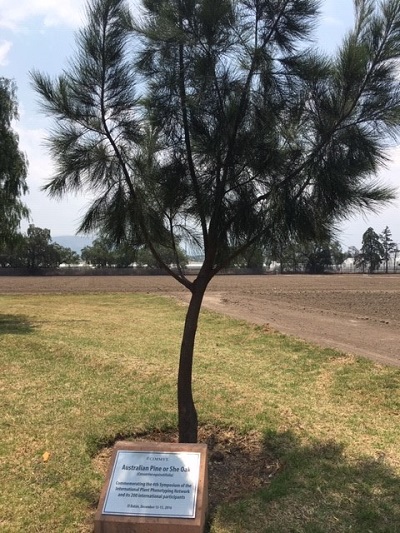
Phenotyping is key to understanding the physiological and genetic bases of plant growth and adaptation and has wide application in crop improvement programs. Recording trait data through sophisticated non-invasive imaging, spectroscopy, image analysis, robotics, high-performance computing facilities and phenomics databases allows scientists to collect information about traits such as plant development, architecture, plant photosynthesis, growth or biomass productivity from hundreds to thousands of plants in a single day. This revolution was the subject of discussion at a 2016 gathering of more than 200 participants at the International Plant Phenotyping Symposium hosted by CIMMYT in Mexico and documented in a special issue of Plant Science.
There is currently an explosion in plant science. Scientists have uncovered the genetic basis of many traits, identified genetic markers to track them and developed ways to measure them in breeding programs. But most of these new findings and ideas have yet to be tested and used in breeding programs, wasting their potentially enormous societal value.
Establishing systems for generating and testing new hypotheses in agriculturally relevant systems must become a priority, Reynolds states in the article. However, for success, this will require interdisciplinary, and often international, collaboration to enable established breeding programs to retool. Most importantly, scientists and funding organizations alike must factor in the long-term benefits as well as the risks of not taking timely action. Translating a research finding into an improved crop that can save lives takes time and commitment. With these two prerequisites, basic plant research can and should positively impact food security.
Authors would like to acknowledge the following funding organizations for their commitment to translational research.
The International Wheat Yield Partnership (IWYP) is supported by the Biotechnology and Biological Sciences Research Council (BBSRC) in the UK; the U. S. Agency for International Development (USAID) in the USA; and the Syngenta Foundation for Sustainable Agriculture (SFSA) in Switzerland.
The Heat and Drought Wheat Improvement Consortium (HeDWIC) is supported by the Sustainable Modernization of Traditional Agriculture (MasAgro) Project by the Ministry of Agriculture and Rural Development (SADER) of the Government of Mexico; previous projects that underpinned HeDWIC were supported by Australia’s Grains Research and Development Corporation (GRDC).
The Queensland Government’s Department of Agriculture and Fisheries in collaboration with The Grains Research and Development Corporation (GRDC) have provided long-term investment for the public sector sorghum pre-breeding program in Australia, including research on the stay-green trait. More recently, this translational research has been led by the Queensland Alliance for Agriculture and Food Innovation (QAAFI) within The University of Queensland.
ASI validation work and ASI translation and extension components with support from the United Nations Development Programme (UNDP) and the Bill and Melinda Gates Foundation, respectively.
Financial support for the maize proVA work was partially provided by HarvestPlus (www.HarvestPlus.org), a global alliance of agriculture and nutrition research institutions working to increase the micronutrient density of staple food crops through biofortification. The CGIAR Research Program MAIZE (CRP-MAIZE) also supported this research.
The CGIAR Research Program on Wheat (WHEAT) is led by the International Maize and Wheat Improvement Center (CIMMYT), with the International Center for Agricultural Research in the Dry Areas (ICARDA) as a primary research partner. Funding comes from CGIAR, national governments, foundations, development banks and other agencies, including the Australian Centre for International Agricultural Research (ACIAR), the UK Department for International Development (DFID) and the United States Agency for International Development (USAID).

Despite the severe social and political unrest that constrain agriculture in Afghanistan, many farmers are growing high-yielding, disease resistant varieties developed through international, science-based breeding and made available to farmers as part of partnerships with national wheat experts and seed producers.
These and other findings have emerged from the first-ever large-scale use of DNA fingerprinting to assess Afghanistan farmers’ adoption of improved wheat varieties, which are replacing less productive local varieties and landraces, according to a paper published yesterday in the science journal BMC Genomics.
The study is part of an activity supported between 2003 and 2018 by the Australian Department of Foreign Affairs and Trade, through which the Agricultural Research Institute of Afghanistan and the International Maize and Wheat Improvement Center (CIMMYT) introduced, tested, and released improved wheat varieties.
“As part of our study, we established an extensive ‘reference library’ of released varieties, elite breeding lines, and Afghan wheat landraces,” said Susanne Dreisigacker, wheat molecular breeder at CIMMYT and lead author of the new paper.
“We then compared wheat collected on farmers’ fields with the reference library. Of the 560 wheat samples collected in 4 provinces during 2015-16, farmers misidentified more than 40%, saying they were of a different variety from that which our DNA analyses later identified.”
Wheat is the most important staple crop in Afghanistan — more than 20 million of the country’s rural inhabitants depend on it — but wheat production is unstable and Afghanistan has been importing between 2 and 3 million tons of grain each year to meet demand.
Over half of the population lives below the poverty line, with high rates of malnutrition. A key development aim in Afghanistan is to foster improved agronomic practices and the use of high quality seed of improved wheat varieties, which together can raise yields by over 50%.
“Fungal diseases, particularly yellow rust and stem rust, pose grave threats to wheat in the country,” said Eric Huttner, research program manager for crops at the Australian Centre for International Agricultural Research (ACIAR) and co-author of the present paper. “It’s crucial to know which wheat varieties are being grown where, in order to replace the susceptible ones with high-performing, disease resistant varieties.”
Varietal adoption studies typically rely on questionnaires completed by breeders, extension services, seed producers, seed suppliers, and farmers, but such surveys are complicated, expensive, and often inaccurate.
“DNA fingerprinting resolves uncertainties regarding adoption and improves related socioeconomic research and farm policies,” Huttner explained, adding that for plant breeding this technology has been used mostly to protect intellectual property, such as registered breeding lines and varieties in more developed economies.
This new study was commissioned by ACIAR as a response to a request from the Government of Afghanistan for assistance in characterizing the Afghan wheat gene bank, according to Huttner.
“This provided the reference library against which farmers’ samples could be compared,” he explained. “Accurately identifying the varieties that farmers grow is key evidence on the impact of introducing improved varieties and will shape our future research
Joint research and development efforts involving CIMMYT, ACIAR, the Food and Agriculture Organization (FAO) of the United Nations, the International Centre of Agricultural Research in Dry Areas (ICARDA), French Cooperation, and Afghanistan’s Ministry of Agriculture, Irrigation and Livestock (MAIL) and Agricultural Research Institute (ARIA) have introduced more than 400 modern, disease-resistant wheat varieties over the last two decades. Nearly 75% of the wheat grown in the areas surveyed for this study comes from these improved varieties.
“New sequencing technologies are increasingly affordable and their cost will continue to fall,” said Dreisigacker. “Expanded use of DNA fingerprinting can easily and accurately identify the wheat cultivars in farmers’ fields, thus helping to target breeding, agronomy, and development efforts for better food security and farmer livelihoods.”
For more information, or to arrange interviews with the researchers, please contact:
Marcia MacNeil, Wheat Communications Officer, CIMMYT
M.MacNeil@cgiar.org, +52 (55) 5804 2004, ext. 2070
Rodrigo Ordóñez, Communications Manager, CIMMYT
r.ordonez@cgiar.org, +52 (55) 5804 2004, ext. 1167
About CIMMYT
The International Maize and Wheat Improvement Center (CIMMYT) is the global leader in publicly funded maize and wheat research and related farming systems. Headquartered near Mexico City, CIMMYT works with hundreds of partners throughout the developing world to sustainably increase the productivity of maize and wheat cropping systems, thus improving global food security and reducing poverty. CIMMYT is a member of CGIAR and leads the CGIAR Research Programs on Maize and Wheat, and the Excellence in Breeding Platform. The center receives support from national governments, foundations, development banks and other public and private agencies.
About ACIAR
As Australia’s specialist international agricultural research for development agency, the Australian Centre for International Agricultural Research (ACIAR) brokers and funds research partnerships between Australian scientists and their counterparts in developing countries. Since 1982, ACIAR has supported research projects in eastern and southern Africa, East Asia, South and West Asia and the Pacific, focusing on crops, agribusiness, horticulture, forestry, livestock, fisheries, water and climate, social sciences, and soil and land management. ACIAR has commissioned and managed more than 1,500 research projects in 36 countries, partnering with 150 institutions along with more than 50 Australian research organizations.
About Afghanistan’s Ministry of Agriculture, Irrigation and Livestock
The Ministry of Agriculture, Irrigation and Livestock (MAIL) of the Islamic Republic of Afghanistan works on the development and modernization of agriculture, livestock and horticulture. The ministry launches programs to support the farmers, manage natural resources, and strengthen agricultural economics. Its programs include the promotion and introduction of higher-value economic crops, strengthening traditional products, identifying and publishing farm-tailored land technologies, boosting cooperative programs, agricultural economics, and export with marketing.
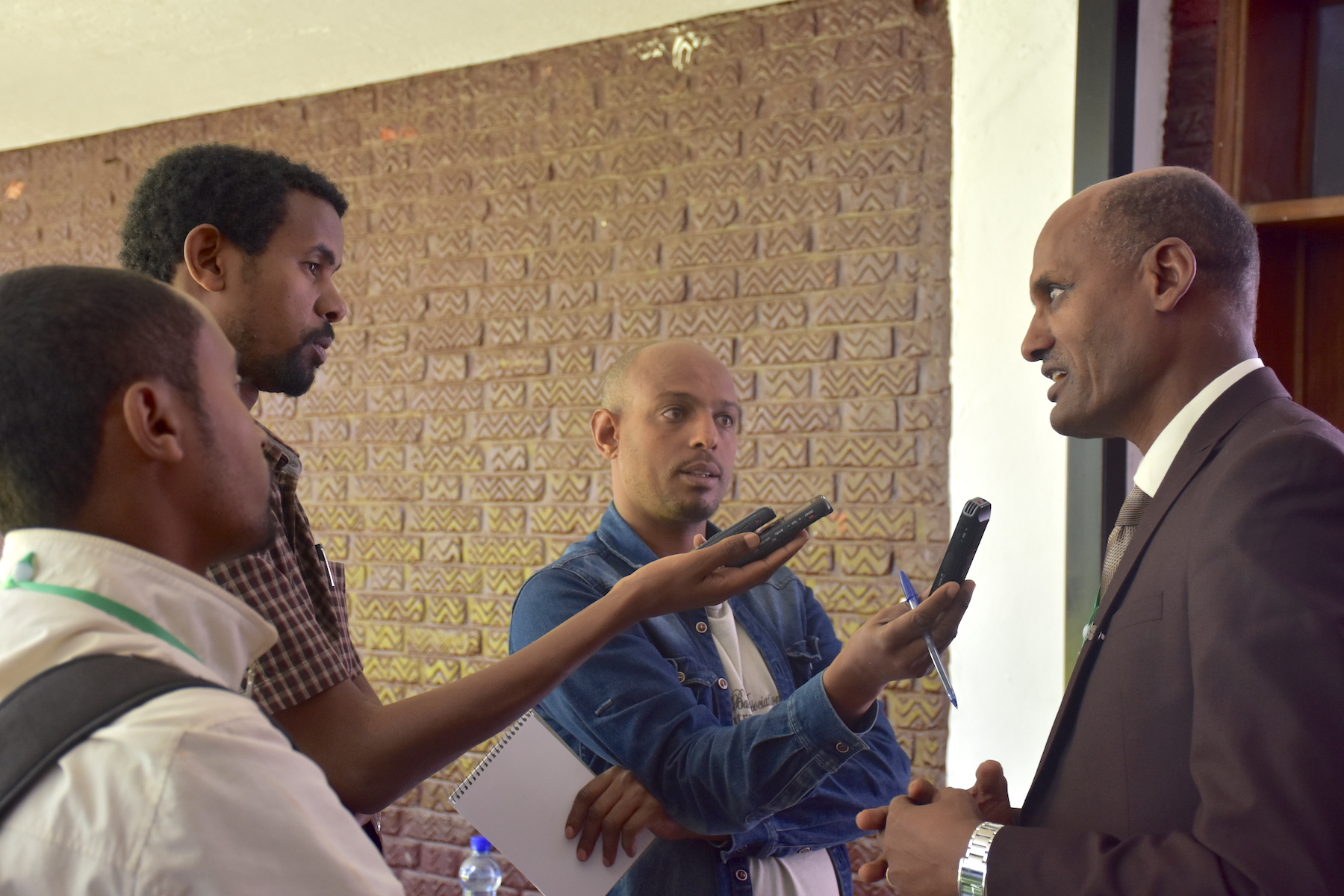
Most African countries have good potential for boosting wheat production if they are supported with technology, innovation and research, said Bekele Abeyo, a senior scientist with the International Maize and Wheat Improvement Center (CIMMYT).
Abeyo, who is based in Ethiopia, which is one of the top wheat-producing countries in Africa, was speaking to BBC Newsday from the International Wheat Congress in the city of Saskatoon in Canada’s western wheat growing province of Saskatchewan.
Interview starts at 31:00:
https://www.bbc.co.uk/sounds/play/w172wpkb45wc459
In Ethiopia, a third of local demand is satisfied by imports, Abeyo said, adding that to reduce import bills, the government is trying to expand wheat production and irrigation in the lowlands where there is high potential for wheat production.
Climate change in Ethiopia and across sub-Saharan Africa is affecting yields, so scientists are working on producing drought-tolerant varieties of wheat. They are also producing biofortified varieties of wheat to help meet nutritional demand for zinc and iron.
More than 800 delegates, including researchers from the CGIAR Research Program on Wheat, CIMMYT, the International Center for Agricultural Research in the Dry Areas (ICARDA), the International Wheat Yield Partnership (IWYP), Cornell University’s Delivering Genetic Gain in Wheat project (DGGW), the University of Saskatchewan and many other organizations are discussing the latest research on wheat germplasm.
The CGIAR Research Program on Wheat (WHEAT), led by the International Maize and Wheat Improvement Center (CIMMYT), is a founding member of the G20 Wheat Initiative, a co-host of the conference.
Wheat provides 20% of all human calories consumed worldwide. In the Global South, it is the main source of protein and a critical source of life for 2.5 billion people who live on less than $2 a day. Wheat is central to conversations about the rural environment, agricultural biodiversity and global food security.
At the opening session of the International Wheat Congress 2019 in Saskatoon, the director general of the International Maize and Wheat Improvement Center (CIMMYT), Martin Kropff, told a gathering of 900 wheat scientists that, with CIMMYT support, Bangladesh developed blast resistant wheat in the quickest possible time. Read more here.
FOR IMMEDIATE RELEASE
SASKATOON, Canada (CIMMYT) — Amid global efforts to intensify the nutritional value and scale of wheat production, scientists from all major wheat growing regions in the world will gather from July 21 to 26, 2019 at the International Wheat Congress in Saskatoon, the city at the heart of Canada’s western wheat growing province, Saskatchewan. The CGIAR Research Program on Wheat (WHEAT), led by the International Maize and Wheat Improvement Center (CIMMYT), is a founding member of the G20 Wheat Initiative, a co-host of the conference.
Wheat provides 20% of all human calories consumed worldwide. In the Global South, it is the main source of protein and a critical source of life for 2.5 billion people who live on less than $2 (C$2.60) a day.
In spite of its key role in combating hunger and malnutrition, the major staple grain faces threats from climate change, variable weather, disease, predators and many other challenges. Wheat’s vital contribution to the human diet and farmer livelihoods makes it central to conversations about the rural environment, agricultural biodiversity and global food security.
More than 800 delegates, including researchers from the CGIAR Research Program on Wheat, CIMMYT, the International Center for Agricultural Research in the Dry Areas (ICARDA), the International Wheat Yield Partnership (IWYP), Cornell University’s Delivering Genetic Gain in Wheat project (DGGW), the University of Saskatchewan and many other organizations worldwide will discuss the latest research on wheat germplasm.
“We must solve a complex puzzle,” said Martin Kropff, CIMMYT’s director general. “Wheat must feed more people while growing sustainably on less land. Wheat demand is predicted to increase 60% in the next three decades, while climate change is putting an unprecedented strain on production.”
“The scientific community is tackling this challenge head-on, through global collaboration, germplasm exchange and innovative approaches. Researchers are looking at wheat’s temperature response mechanisms and using remote sensing, genomics, bio-informatics and other technologies to make wheat more tolerant to heat and drought,” Kropff said.
The congress is the first major gathering of the wheat community since the 2015 International Wheat Conference in Sydney, Australia.
CGIAR and CIMMYT scientists will share the latest findings on:
For more details on schedule and scientists’ presentations, click here.
Research shows that more than 60% of wheat varietal releases since 1994 were CGIAR-related.
Low- and middle-income countries are the primary focus and biggest beneficiaries of CGIAR wheat research, but high-income countries reap substantial rewards as well. In Canada, three-quarters of the wheat area is sown to CGIAR-related cultivars and in the United States almost 60% of the wheat area was sown to CGIAR-related varieties, according to the research.
WHEN
July 21-26, 2019
The opening ceremony and lectures will take place on
Monday, July 22, 2019 from 08:50 to 10:50 a.m.
WHERE
TCU Place
35 22nd Street East,
Saskatoon, SK S7K 0C8, Canada
https://g.page/TCUPlace
CONTACTS
For further information, or to arrange interviews, please contact:
Marcia MacNeil: m.macneil@cgiar.org
Julie Mollins: j.mollins@cgiar.org
About CGIAR
CGIAR is a global research partnership for a food secure future dedicated to reducing poverty, enhancing food and nutrition security, and improving natural resources.
About the CGIAR Research Program on Wheat
Joining advanced science with field-level research and extension in lower- and middle-income countries, the Agri-Food Systems CGIAR Research Program on Wheat (WHEAT) works with public and private organizations worldwide to raise the productivity, production and affordable availability of wheat for 2.5 billion resource-poor producers and consumers who depend on the crop as a staple food. WHEAT is led by the International Maize and Wheat Improvement Center (CIMMYT), with the International Center for Agricultural Research in the Dry Areas (ICARDA) as a primary research partner. Funding for WHEAT comes from CGIAR and national governments, foundations, development banks and other public and private agencies, in particular the Australian Centre for International Agricultural Research (ACIAR), the UK Department for International Development (DFID) and the United States Agency for International Development (USAID). www.wheat.org
About CIMMYT
The International Maize and Wheat Improvement Center (CIMMYT) is the global leader in publicly funded maize and wheat research and related farming systems. Headquartered near Mexico City, CIMMYT works with hundreds of partners throughout the developing world to sustainably increase the productivity of maize and wheat cropping systems, thus improving global food security and reducing poverty. CIMMYT is a member of CGIAR and leads the CGIAR Research Programs on Maize and Wheat, and the Excellence in Breeding Platform. The center receives support from national governments, foundations, development banks and other public and private agencies.
On May 15, 2019, as part of the CGIAR System Council meeting held at the ILRI campus in Addis Ababa, Ethiopia, around 200 Ethiopian and international research and development stakeholders convened for the CGIAR Agriculture Research for Development Knowledge Share Fair. This exhibition offered a rare opportunity to bring the country’s major development investors together to learn and exchange about how CGIAR investments in Ethiopia help farmers and food systems be more productive, sustainable, climate resilient, nutritious, and inclusive.
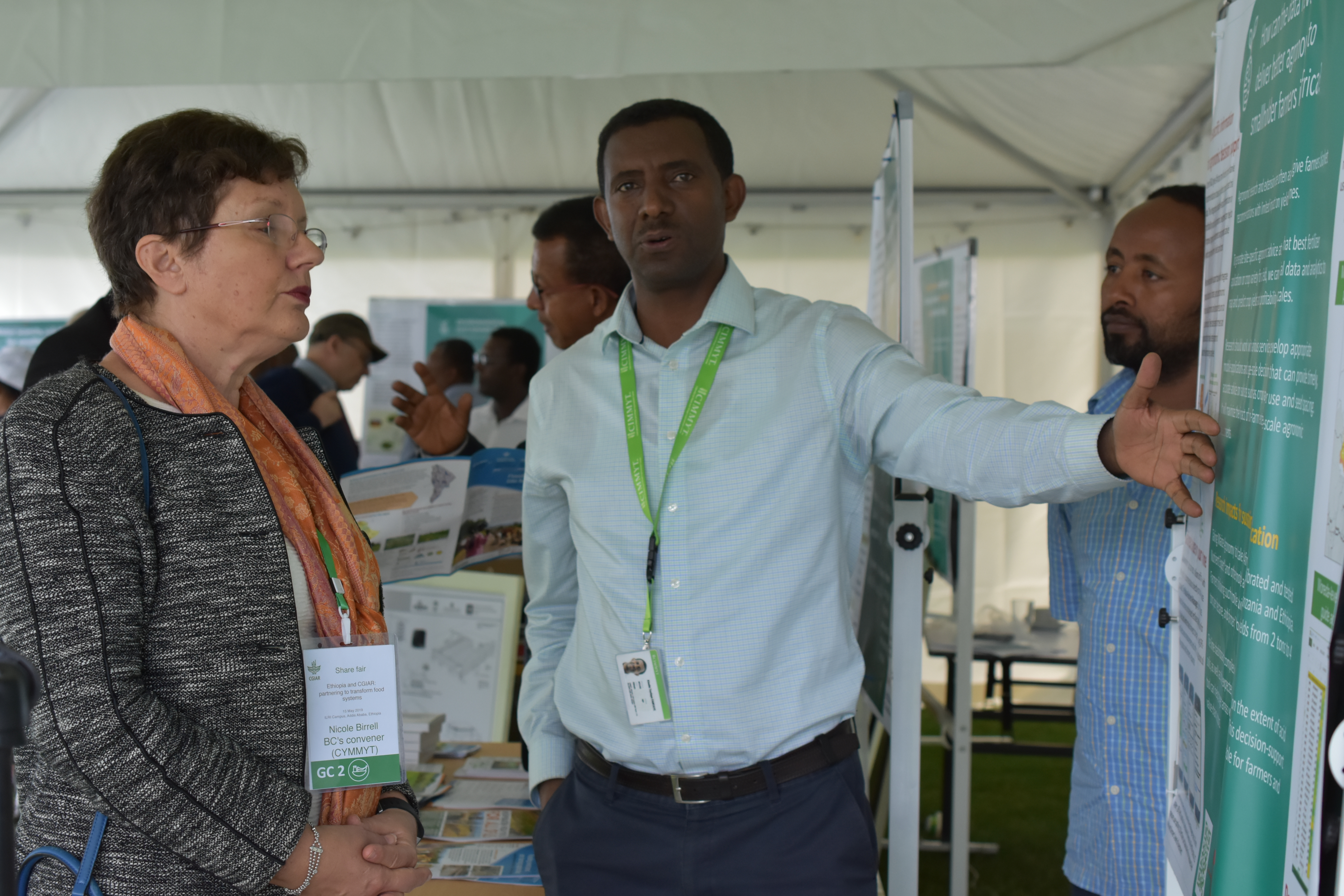
Under the title One CGIAR — greater than the sum of its parts — the event offered the opportunity to highlight close partnerships between CGIAR centers, the Ethiopian government and key partners including private companies, civil society organizations and funding partners. The fair was organized around the five global challenges from CGIAR’s business plan: planetary boundaries, sustaining food availability, promoting equality of opportunity, securing public health, and creating jobs and growth. CGIAR and its partners exhibited collaborative work documenting the successes and lessons in working through an integrated approach.
There were 36 displays in total, 5 of which were presented by CIMMYT team members. Below are the five posters presented.
How can the data revolution help deliver better agronomy to African smallholder farmers?
This sustainability display showed scalable approaches and tools to generate site-specific agronomic advice, developed through the Taking Maize Agronomy to Scale in Africa (TAMASA) project in Nigeria, Tanzania and Ethiopia.
Maize and wheat: Strategic crops to fill Ethiopia’s food basket
This poster describes how CGIAR works with Ethiopia’s research & development sector to support national food security priorities.
Addressing gender norms in Ethiopia’s wheat sector
Research shows that restrictive gender norms prevent women’s ability to innovate and become productive. This significantly impacts Ethiopia’s economy (over 1% GDP) and family welfare and food security.
Quality Protein Maize (QPM) for better nutrition in Ethiopia
With the financial support of the government of Canada, CIMMYT together with national partners tested and validated Quality Protein Maize as an alternative to protein intake among poor consumers.
Appropriate small-scale mechanization
The introduction of small-scale mechanization into the Ethiopian agriculture sector has the potential to create thousands of jobs in machinery service provision along the farming value chain.
About the CGIAR System Council
The CGIAR System Council is the strategic decision-making body of the CGIAR System that keeps under review the strategy, mission, impact and continued relevancy of the System as a whole. The Council meets face-to-face not less than twice per year and conducts business electronically between sessions. Additional meetings can be held if necessary.
Related outputs from the Share Fair 2019
The Wheat Productivity Enhancement Program aims to enhance and protect the productivity of wheat in Pakistan by supporting research that leads to the identification, adoption, and optimal agronomic management of new, high yielding, disease-resistant wheat varieties. The main goal of the project is to facilitate efforts of scientific institutions in Pakistan to minimize adverse effects of wheat rusts — including the highly virulent Ug99 stem rust disease — through surveillance and genetically resistant varieties.
As part of the U.S. government’s assistance to Pakistan, the U.S. Department of Agriculture (USDA) and Pakistan’s Ministry of Agriculture have identified the development of wheat varieties with resistance to virulent rust strains as a goal for improving food security and related agricultural production challenges. This document outlines a project for providing cereal rust protection for wheat production in Pakistan.
This wheat production enhancement project is a multi-partner, collaborative research and development program that includes human resource development. The primary external partners — USDA, CIMMYT, and the International Center for Agricultural Research in the Dry Areas — work cooperatively with Pakistan research organizations to refine work plans and implement research and development activities in rust surveillance, pre-breeding, breeding, seed, and agronomy as described in objectives section.
The International Wheat Improvement Program was established as a cooperative international research effort by the Turkish national wheat research program and the International Maize and Wheat Improvement Center (CIMMYT) in 1986. The International Center for Agricultural Research in the Rural Areas (ICARDA) joined the program in 1990, integrating its highland wheat breeding program.
The main objective of IWWIP is to develop winter/facultative wheat germplasm for the region of Central and West Asia. IWWIP is fully integrated into the national Turkish wheat program, with a strong connection to partners within and outside the region, such as eastern Europe and the United States.
The program is governed by a steering committee. Three coordinators — Beyhan Akin from CIMMYT, Mesut Keser from ICARDA and Fatih Ozdemir from the Turkish national wheat research program — provide technical leadership.
IWWIP focuses on the development of elite wheat lines for rainfed and irrigated areas in Central and West Asia.
Since the inception of the program, more than 105 winter wheat varieties originating from IWWIP germplasm have been released. Germplasm from IWWIP is sent each year to approximately 100 cooperators in 50 countries, making it an important vehicle for the global exchange of winter wheat germplasm.
Core traits for rainfed areas are yield and yield stability, drought and heat tolerance, resistance to three cereal rusts and soil-borne diseases — nematodes, crown and root rots —, and end-use quality. Other traits considered for specific areas are resistance to Septoria leaf blight and insects. For irrigated and high-rainfall areas, breeding focuses on yield potential, cereal rusts, Septoria and quality.
Germplasm with special traits, such as resistance to stem rust and Russian wheat aphid, and Sun pest vegetative stage resistance, is developed in nurseries and shared with IWWIP cooperators. IWWIP distributes four International Winter Wheat Nurseries each year, targeted for semiarid and irrigated conditions: Facultative and Winter Wheat Observation Nurseries (FAWWONs) FAWWON-SA and FAWWON-IRR, and the replicated International Winter Wheat Yield Trials (IWWYTs) IWWYT-SA and IWWYT-IRR.
In 2018, IWWIP established a speed-breeding facility at the Aegean Agricultural Research Institute in Menemen, Izmir, with the capacity to grow 20,000 plants in one cycle. This facility allows for greater genetic gain by increasing the number of generations per year and reducing the time it takes to incorporate new traits into elite germplasm.
IWWIP uses multi-location testing in Turkey as well as shuttle breeding globally, serving as a successful model for a jointly operated breeding program between national and international institutes. Shuttle breeding to improve drought and heat tolerance and cold tolerance has been working well and produces novel germplasm with abiotic stresses tolerance.
Major IWWIP contributions:
IWWIP has played a major role in building the capacity of young researchers through long-term practical training at CIMMYT, ICARDA, and Turkish national wheat breeding programs; participation in traveling seminars; support for participation in regional conferences and IWWIP annual meetings; and on-site visits of IWWIP breeders.
Climate-change-induced heat stress and disease pathogens migrating across borders threaten the world’s wheat supply and food security in Africa and the Middle East. Building on the Durable Rust Resistance in Wheat (DRRW) global partnership, Delivering Genetic Gain in Wheat (DGGW) will mitigate serious threats to wheat brought about by climate change and develop and deploy new strains of wheat that are heat tolerant as well as resistant to wheat rusts and other diseases.
Cornell University has been awarded a $24 million grant by the Bill & Melinda Gates Foundation to continue to fund and expand the work of the Borlaug Global Rust Initiative (BGRI).
DGGW uses modern tools of comparative genomics and big data to develop and deploy varieties of wheat that incorporate climate resiliency as well as improved disease resistance for smallholder farmers in these politically vulnerable regions.”
The four-year grant builds on the successes of the BGRI, led by the DRRW project, funded by the UK Department for International Development and the Bill & Melinda Gates Foundation from 2008 to 2016.
Deadly wheat pathogens have been moving from the wheat fields of northern and East Africa into the Middle East. In their rush to identify genes that can resist evolving and virulent new strains of the disease known as stem rust, BGRI scientists have developed collaborative arrangements and facilities, with the crucial support of national governments and agencies, to screen thousands of samples of wheat each year from every continent under rust infection, to identify resistant lines.
DGGW is based at Cornell University and acts as the secretariat for the BGRI. Collaborations continue with national partners in Kenya and Ethiopia, as well as scientists at international agricultural research centers that focus on wheat, including CIMMYT and the International Center for Agricultural Research in the Dry Areas.
Advanced research laboratories in the U.S., Canada, China, Turkey, Denmark, Australia and South Africa collaborate on the project. So far, more than 2,000 scientists from 35 international institutions spread across 23 countries are involved in the consortium, and 37 countries contribute data to the surveillance network.
How to scale? This question frequently comes up as projects look to expand and replicate results. In order to sustain enduring impacts for projects after their lifetime, agricultural programs are turning to scaling strategies. These strategies look beyond the numbers that are reached within a project and include sustainability and transformation beyond the project context. Methods and tools exist that help anticipate realistic and responsible scaling pathways.
The Scaling team at the International Maize and Wheat Improvement Center (CIMMYT), led by Lennart Woltering, drives the initiative to incorporate scaling principles into existing and developing projects to maximize impact.
Maria Boa recently joined the team as Scaling Coordinator. Last year Boa and Woltering participated in regional meetings on scaling in Morocco, Tunisia and Vietnam, which highlighted the need for better dissemination of information on how to approach scaling, in addition to its benefits.

According to Boa, one of the key messages highlighted throughout these events was that in order for scaling to take hold and be integrated into projects, “…there needs to be a shift in mindset to accept that change is complex and that most projects only address a fraction of the problem.” This is essential in using scaling to effectively support long-term results.
At a workshop in Tunisia organized by ICARDA, IFAD and CIMMYT in November 2018, many participants expressed interest in scaling strategy tools, but were puzzled on how to integrate them into their specific projects. Many determined that they were stuck developing scaling strategies in an outdated framework, or one that strictly focused on using technological innovations. One participant admitted that she was skeptical of scaling perspectives because many did not lie in her field of expertise.
The November 2018 CCAFS SEA Conference on Scaling in Vietnam provided a platform for the sharing and learning of experiences in the scaling world. Some of the key messages from the event included the importance of scaling agricultural innovations taking place in complex systems of agricultural transformation, and the necessity of joint cooperation from all involved stakeholders and their openness to taking on challenges as a way to support sustainable system change.
According to Boa, scaling is a process that heavily relies on strategic collaboration for lasting impact. “Projects often don’t take into account how they’re a part of a larger chain of potential change,” she says.
Already recognized as a sustainable leader within scaling, CIMMYT is looking to strengthen scaling efforts in order to foster a more enduring impact within CIMMYT projects and beyond.

Currently, the Scaling team at CIMMYT is conducting research on the “science of scaling” as it continues to function as a “help desk,” providing support integrating scaling principles in proposals and projects. Its primary role is to consider a project’s scaling needs and guide the development of an informed strategy to leverage efforts and resources. Boa hopes that by integrating responsible scaling approaches early on, projects can better balance the trade-offs associated with change.
Success in scaling is measured by a project’s enduring impact. However, stakeholders need more experience and capacity to see programs through to their end and be willing to monitor them beyond that lifespan. CIMMYT is developing and collecting the tools to support stakeholders with these specific capacities.
Developing a scaling strategy can also bring additional benefits: a discussion about scaling opens the door for raising awareness and fostering actions among different stakeholders towards system change and sustainable impact.
Around 115 members of the CGIAR breeding community, plus others representing national programs, universities, funders and the private sector, met for a three-day discussion of how to co-develop the next generation of advanced breeding programs that will improve the rate at which resource-poor farmers are able to adopt improved varieties that meet their needs.
The annual Excellence in Breeding Platform (EiB) Contributor’s meeting, held this year in Amsterdam from 13-15 November, caps a year of engagement with CGIAR Centers and national agricultural research system (NARS) partners around the world.
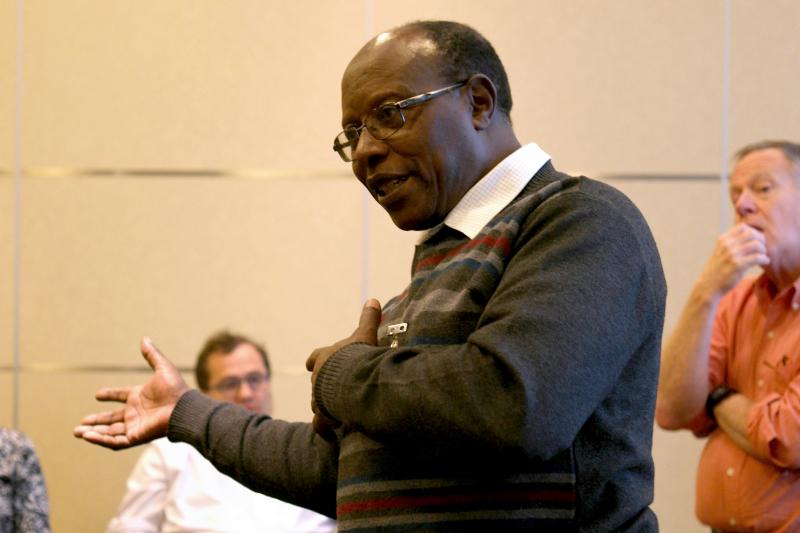
“Although breeding is one of the oldest functions in CGIAR, we have never had a meeting like this with scientists from all the centers,” said Michael Baum, director of Biodiversity and Crop Improvement at the International Center for Agricultural Research in the Dry Areas, (ICARDA). “Within CGIAR, plant breeding started as a science, but now we are looking at how to implement it not as a science but as an operation, as it is done in the private sector, so there are many new concepts.”
Key items on the agenda for November were new tools to develop product profiles and create improvement plans that will define the modernization agenda in each center and across the Platform itself, based in part on the Breeding Program Assessment Tool (BPAT) that most Centers completed in 2018.
The conversation was enriched by Paul Kimani (University of Nairobi) presenting on the Demand-led Variety Design project, which produced the book, “The Business of Plant Breeding.”
Ranjitha Puskur, gender research coordinator at the International Rice Research Institute (IRRI), started an animated discussion on how to incorporate gender into product design by thinking about customer segments.
Tim Byrne from AbacusBio introduced methods for identifying farmer preferences to be targeted by breeding programs.
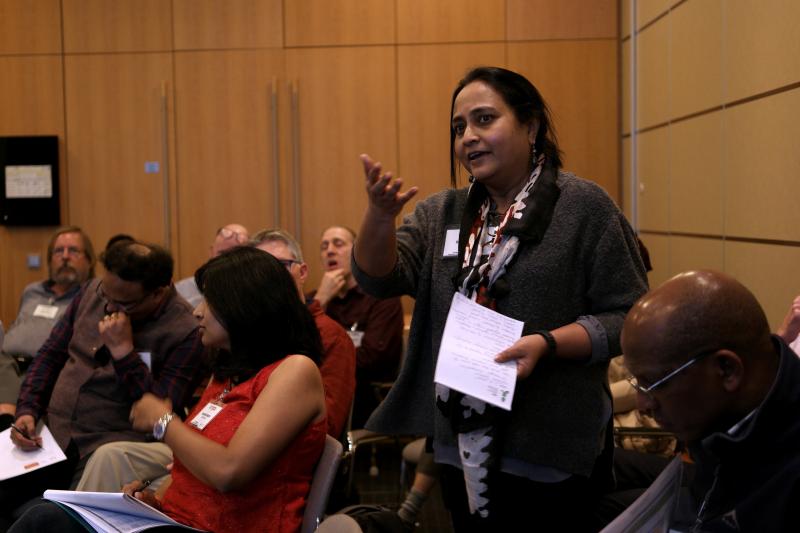
In breakout sessions, contributors were able to have detailed discussions according to their various specializations: phenotyping, genotyping and bioinformatics/data management. The direct feedback from contributors will be incorporated into EiB workplans for training and tool development for the coming year.
A key outcome of the meeting was an agreement to finalize the product profile tool, to be made available to EiB members in early December 2018. The tool helps breeders to work with other specialisms, such as markets, socioeconomics and gender, to define the key traits needed in new products for farmers. This helps to focus breeding activities towards areas of greatest impact, supports NARS to play a greater role, and creates accountability and transparency for donors, in part by defining the geographic areas being targeted by programs.
“Breeding trees is different to the annual crops,” said Alice Muchugi, genebank manager at the World Agroforestry Centre (ICRAF), “but we are seeing what we can borrow from our colleagues. By uploading what we are doing in maps, for example, donors are able to perceive the specific challenges we are undertaking.”
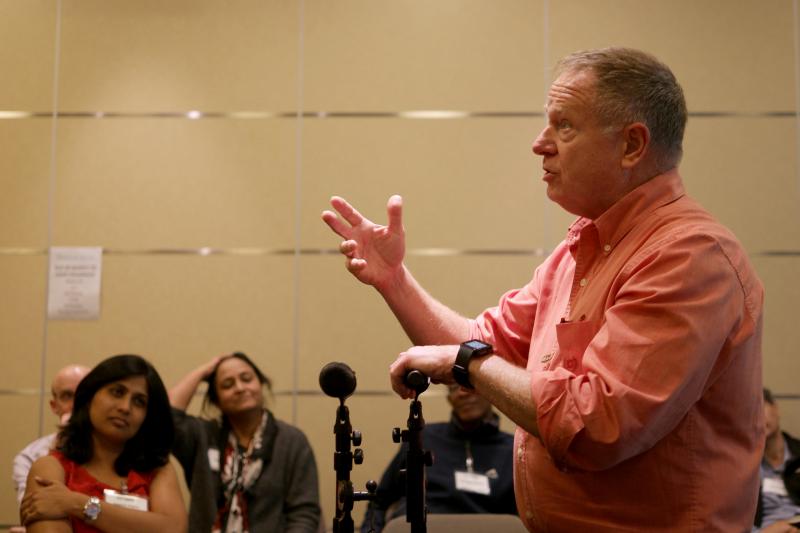
“I think we have realized there are lot of challenges in common, and the Platform is helping us all work on those,” said Filippo Bassi, durum wheat breeder at ICARDA. “I like to see all the people around the room, if you look at the average age there is a big shift; the number of countries present also tells you a lot.”
Tabare Abadie, R&D external academic outreach lead at Corteva Agriscience, also saw the meeting as a good opportunity to meet a broader group of people. “One of the take homes I hear is [that] there are a lot of challenges, but also a lot of communication and understanding. For me as a contributor it’s an incentive to keep supporting EiB, because we have gone through those changes before [at Corteva], and we can provide some know-how and experience of what happens,” Abadie explained.
“There are still a lot of gaps to fill, but this is a good start,” said Thanda Dhliwayo, maize breeder at the International Maize and Wheat Improvement Center (CIMMYT). “We need to get everyone involved, from leadership down to the guys working in the field.”
Michael Quinn, director of the CGIAR Excellence in Breeding Platform, discusses the CGIAR’s initiative on crops to end hunger.
ADDIS ABABA, Ethiopia (CIMMYT) — Ethiopia’s leading agriculture and policy specialists will craft a new strategy to dramatically raise national wheat production and achieve self-sufficiency for the crop by 2022, at a special conference organized by the Government of Ethiopia and the International Maize and Wheat Improvement Center (CIMMYT) for November 23, 2018.
Annual imports to satisfy Ethiopia’s demand for wheat — one of the country’s four key food crops — now cost more than $600 million and expose national food security to capricious global price shifts for grain, according to Mandefro Nigussie, Director General of the Ethiopian Institute of Agriculture (EIAR).
“Ethiopians now consume some 6.5 million tons per year but the country’s 4.2 million households grow only 4.6 million tons on 1.7 million hectares and demand for the crop is rising, as more people move to cities and change in life style,” Nigussie explained.
National wheat yields are steadily climbing but still average only 2.7 tons per hectare; well below global standards, according to Bekele Abeyo, CIMMYT wheat scientist and Ethiopia country representative.
“There’s great potential to expand irrigated wheat production, especially in the lowlands along the major river basins,” Nigussie said. “In the Ethiopian highlands, wheat’s traditional environment, more farmers need to use high-yielding, disease resistant seed and modern farming practices. Even modest levels of technology adoption can provide yields as high as 4 tons per hectare.” Wheat yield can also be increased significantly by treating acidic soils and by making broad-beds in vertisol soil areas.
Called “Wheat Self-Sufficiency in Ethiopia: Challenges and Opportunities,” the consultative workshop builds on recent successes and lessons in Ethiopia of the Wheat Initiative, an international partnership of private and public organizations that conducts wheat research for food security and to help wheat farmers in diverse environments to improve and stabilize their yields.
To be held in the Hiruy Meeting Hall at the headquarters of the Ethiopian Institute of Agricultural Research (EIAR), Addis Ababa, the event will draw some 70 participants, including representatives of Ethiopia’s ministries of agriculture, EIAR, regional agricultural research institutes, the Ethiopian Seed Enterprise, Oromia Seed Enterprise, and the Agricultural Transformation Agency. Adding their experience and ideas will be experts on wheat trade, irrigation and energy, finance and economic cooperation, along with representatives from the Regional Bureau of Agriculture, millers associations, funding agencies, and global organizations including the International Center for Agricultural Research in the Dry Areas (ICARDA) and the International Food Policy Research Institute (IFPRI).
“Aims will include strengthening wheat research and development partnerships, tapping into policies that foster competitive and profitable wheat farming, and supporting national efforts both to reduce imports and end poverty and food insecurity,” Abeyo explained. Kristie Drucza, Gender and Development Specialist at CIMMYT, also notes that, “We see striking opportunities to raise productivity by empowering women in wheat farming, fostering their access to knowledge, technology, and financial resources and their voice in decision making.”
WHAT:
“Wheat Self-Sufficiency in Ethiopia: Challenges and Opportunities” conference
WHEN:
Friday, November 23, 2018
WHERE:
Hiruy Meeting Hall
Ethiopian Institute of Agricultural Research (EIAR)
Addis Ababa, Ethiopia
https://goo.gl/maps/YPN5vuGb5qB2
For more information, to attend the conference or for media interviews, please contact
Jerome Bossuet, Communications Officer, CIMMYT. J.Bossuet@cgiar.org
Ethiopia and CIMMYT. Since 1970, Ethiopian farmers have had access to more than 100 high-yielding bread and durum wheat varieties developed and spread through collaboration among EIAR, Ethiopia’s regional agricultural research institutes, and CIMMYT, whose work has contributed to 70 percent of Ethiopia’s wheat varietal development. Use of these high-yielding, disease resistant varieties, along with supportive government policies and better cropping practices, have caused Ethiopia’s average annual wheat production to grow more than double since the early 2000s.
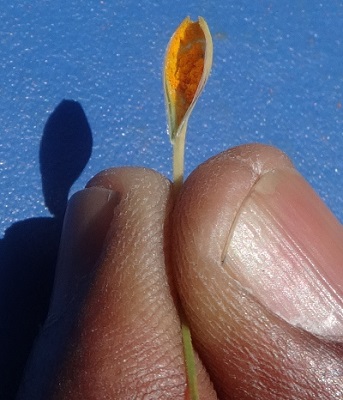
Rapidly emerging and evolving races of wheat stem rust and stripe rust disease—the crop’s deadliest scourges worldwide—drove large-scale seed replacement by Ethiopia’s farmers during 2009-14, as the genetic resistance of widely-grown wheat varieties no longer proved effective against the novel pathogen strains, according to a new study by the International Maize and Wheat Improvement Center (CIMMYT).
Based on two surveys conducted by CIMMYT and the Ethiopian Institute of Agricultural Research (EIAR) and involving more than 2,000 Ethiopian wheat farmers, the study shows that farmers need access to a range of genetically diverse wheat varieties whose resistance is based on multiple genes.
After a severe outbreak in 2010-11 of a previously unseen stripe rust strain, 40 percent of the affected farm households quickly replaced popular but susceptible wheat varieties, according to Moti Jaleta, agricultural economist at CIMMYT and co-author of the publication.
“That epidemic hit about 600,000 hectares of wheat—30 percent of Ethiopia’s wheat lands—and farmers said it cut their yields in half,” Jaleta said. “In general, the rapid appearance and mutation of wheat rust races in Ethiopia has convinced farmers about the need to adopt newer, resistant varieties.”
The fourth most widely grown cereal after tef, maize, and sorghum, wheat in Ethiopia is produced largely by smallholder farmers under rainfed conditions. Wheat production and area under cultivation have increased significantly in the last decade and Ethiopia is among Africa’s top three wheat producers, but the country still imports on average 1.4 million tons of wheat per year to meet domestic demand.
National and international organizations such as EIAR, CIMMYT, and the International Centre for Agricultural Research in the Dry Areas (ICARDA) are working intensely to identify and incorporate new sources of disease resistance into improved wheat varieties and to support the multiplication of more seed to meet farmer demand.
New wheat varieties have provided bigger harvests and incomes for Ethiopia farmers in the last decade, but swiftly mutating and spreading disease strains are endangering wheat’s future, according to Dave Hodson, CIMMYT expert in geographic information and decision support systems, co-author of the new study.
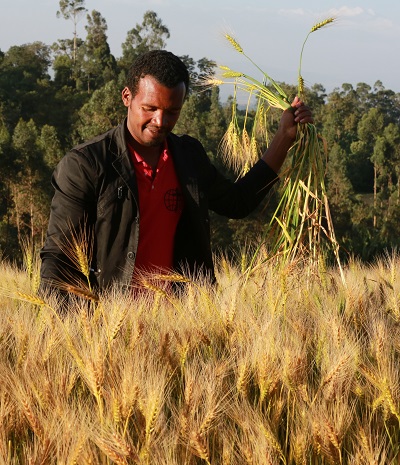
“In addition to stripe rust, highly-virulent new races of stem rust are ruining wheat harvests in eastern Africa,” he explained. “These include the deadly Ug99 race group, which has spread beyond the region, and, more recently, the stem rust race TKTTF.”
As an example, he mentioned the case of the wheat variety Digalu, which is resistant to stripe rust and was quickly adopted by farmers after the 2010-11 epidemic. But Digalu has recently shown susceptibility to TKTTF stem rust and must now be replaced.
“In rust-prone Ethiopia, the risks of over-reliance on a widely-sown variety that is protected by a single, major resistance gene—Digalu, for example—are clearly apparent,” he added. “CIMMYT and partners are working hard to replace it with a new variety whose resistance is genetically more complex and durable.”
Hodson said as well that continuous monitoring of the rust populations in Ethiopia and the surrounding region is essential to detect and respond to emerging threats, as well as to ensure that the key pathogen races are used to screen for resistance in wheat breeding programs.
Hodson and partners at the John Innes Centre, UK, and EIAR are leading development of a handheld tool that allows rapid identification of disease strains in the field, instead of having to send them to a laboratory and lose precious time awaiting the results.
CIMMYT and partners are also applying molecular tools to study wheat varietal use in Ethiopia. “There are indications that yields reported by farmers were much lower than official statistics, and farmer recollections of varietal names and other information are not always exact,” Hodson explained. “We are analyzing results now of a follow-up study that uses DNA fingerprinting to better document varietal use and turnover.”
The authors would like to acknowledge the Standing Panel for Impact Assessment (SPIA) for financing, the Diffusion and Impacts of Improved Varieties in Africa (DIIVA) project that supported the first survey in 2011, and Cornell University, the Bill & Melinda Gates Foundation, and United Kingdom’s Department for International Development (DFID) through the Durable Rust Resistance in Wheat (DRRW, now called Delivering Genetic Gain in Wheat) project for support for the second survey in 2014.
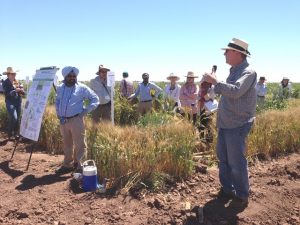
OBREGON, Mexico (CIMMYT) — For hundreds of international agricultural development experts, an annual gathering in northern Mexico provides a vital platform for sharing and debating the latest wheat breeding news and research.
This year, more than 200 members of the wheat community from more than 30 countries met in the legendary wheat fields of Ciudad Obregon in Mexico’s state of Sonora to participate in Visitors’ Week, hosted by the Global Wheat Program (GWP) of the International Maize and Wheat Improvement Center (CIMMYT).
The event coincides with the birthday of Norman Borlaug, the late CIMMYT wheat breeder and Nobel Peace Prize laureate, known as the father of the Green Revolution for his contributions to global food security, many of which were undertaken in Obregon. This year, Visitors’ Week delegates toasted his 102nd birthday at the Norman E. Borlaug Experimental Field research station.
The month of March also marks the peak wheat-growing season in Obregon, and participants attended a field day tour to see old and new wheat varieties, learn about CIMMYT programs and the latest research findings. Additionally, meetings and discussions were held with the goal of contributing to the improvement of wheat research across the globe by identifying key priorities.
INTERNATIONAL DIALOGUES
A brainstorming session between representatives from the British government and CIMMYT included discussions on collaborating on breeding for tolerance to high ambient temperatures, durable disease resistance, nitrogen use efficiency, and quality and nutrition.
Future collaborations between CIMMYT and Australia were explored with the Grains Research and Development Corporation and the CIMMYT-Australia-ICARDA Germplasm Exchange (CAIGE) group. 2Blades, a U.S.-based organization supporting the development of durable disease resistance in crop plants, joined the discussion and expressed the need to use safe, sustainable crop production strategies.
As part of discussions regarding international collaboration, the second meeting of the Expert Working Group on Nutrient Use Efficiency in wheat aimed to improve international coordination on NUE (nitrogen and other nutrients) research among Australia, Britain, France, Mexico, Italy, Spain and Germany.
During the NUE meeting, an executive committee was appointed, with Malcolm Hawksford, head of Plant Biology and Crop Science at Rothamsted Research as chair and Jacques Le Gouis, of the French National Institute for Agricultural Research, as vice chair.
As well, the International Wheat Yield Partnership (IWYP) held its first official conference during which IWYP director Jeff Gwyn discussed outcomes and objectives for the next 20 years.
Due to the large audience of global wheat researchers, the Borlaug Global Rust Initiative took the opportunity to launch its new project, Delivering Genetic Gain in Wheat (DGGW), supported by a $24 million grant from the Bill & Melinda Gates Foundation. Under the DGGW, CIMMYT scientists aim to mitigate serious threats to wheat brought about by climate change by developing and deploying new heat-tolerant, disease-resistant wheat varieties.
ENCOURAGING ENGAGEMENT
With the hope of increasing data and information sharing, the International Wheat Improvement Network (IWIN) awarded Mehmet Nazım Dincer of Turkey the IWIN Cooperator Award for contributing data on international nurseries. Through a lottery, Dincer was selected from among researchers who provided data on international seed nurseries to IWIN in 2015. Dincer was awarded a one-week paid visit to Obregón during GWP Visitors’ Week, and was also congratulated for his collaborative efforts during the festivities.
Another lottery will be held in November to select the next winner from among cooperators who return 2016 international nursery data. GWP director Hans Braun joked that he is not aware of other lotteries with so few participants in which the jackpot is a trip to Obregon, encouraging IWIN cooperators to return their data and win.
Visitors’ Week is not only an important time for international collaborations and brainstorming, but also for capacity development and training early career scientists. Coinciding with this year’s Visitors’ Week was the GWP Basic Wheat Improvement Course (BWIC), a three-month training course for young and mid-career scientists focusing on applied breeding techniques in the field. In addition to attending Visitors’ Week events, trainees were offered special courses with guest lecturers.
Joining the BWIC at this time were winners of the 2016 Women in Triticum Award who alongside women trainees attended a “Women in Agriculture” discussion led by Jeannie Borlaug, daughter of Norman Borlaug, to discuss difficulties and successes women face in achieving equality in the science and agriculture sectors.